List Of Common Running Injuries
Reading a page about running injuries is a bit like reading one of those encyclopaedia medical dictionaries – suddenly you start to experience symptoms that are not really there! So common sense rules apply – listen to your body
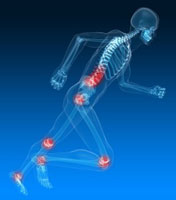
A running injury is often caused by repetitive overuse, it is just the nature of the beast I'm afraid
(Working on good running form is one strategy for easing the strain on muscles and joints)
If you are a beginner runner watch out for the "too much too soon" syndrome! Always build up gradually to give your body time to adjust
If you get sharp pain during a run, then the best advice is stop or walk until it stops hurting. If it doesn't ease after a few minutes then do not resume running, go home and follow the RICE method (Rest, Ice, Compress and Elevate). This also applies if you get aches and pains following a run
For more injury free running tips we have a page here
For now, let’s get started:
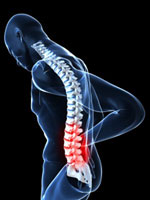
Lower Back
Unless there is a pre-existing back problem, lower back injuries and aches will be muscular and likely to be temporary. Impact forces from your feet, through the legs and up to the hips and lower spine often cause back aches, especially if you have incorrect running technique. Biomechanical factors such as incorrect running form - bending at the waist or running with hips pressed too far back - can cause lower back pain (Upper back pain is often caused by tension in the shoulders or scrunching)
Hips And Thighs
Hip Bursitis
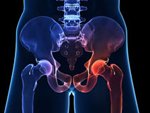
A bursa is a small fluid-filled sac in a joint which protects the bones from friction and compression (a bit like a blister gel pad!), if this sac becomes inflamed through repetitive stress, direct damage (fall on hip), or infection then it becomes sore. The pain will be quite localised to one area which may feel warm and painful to the touch.
Iliotibial Band Syndrome
One of the most common running injuries is in the Iliotibial band - a thick band of fibrous tissue running from the hip to the shin which stabilizes the knee - when inflamed this can cause pain throughout the whole area. Hill running and running on a banked track with a constant bending or turning of the downhill leg will aggravate this condition
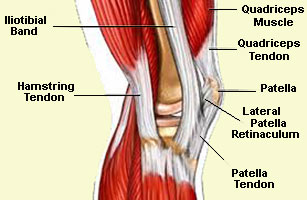
Hamstring Strain
The hamstrings cross up the back of the thigh and act on the joints of the knee and hip. It is a large muscle and the degree of damage from a strain or pull can be measured by the degree of pain and weight bearing capabilities
Running Injuries - Knee
Dislocated Kneecap
Also known as Patellar Subluxation Syndrome, this is where the kneecap moves out of its socket usually laterally to the outside
Plica Syndrome
The Plica are remnants of faecal tissue which help form the lining (synovial) tissues of the knees. When the knee bends repeatedly the tissues become open to injury - running long distances without the right training and preparation can lead to this condition
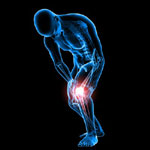
Patellofemoral Syndrome
This is probably the most common of running injuries, better known as runners knee! Pain is felt behind and around the knee cap, often on the outside edge, and you may experience a popping or grinding sensation. This happens because the knee cap does not move smoothly and centrally through the femoral groove. There will be little or no swelling despite the pain
Ankles & Feet
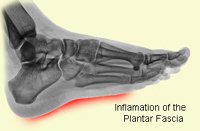
Plantar Fasciitis
One of the common running injuries is plantar fasciitis, caused by the fascia tissues (tendons and ligaments) of the arch of the foot becoming over stretched and losing flexibility. One of the first signs of this condition is pain first thing in the morning when you put your heel down (or after a long period of sitting)
Blisters
These are very common for runners - now then, do you pop them or not? The blister is there to protect but continued rubbing on the surface can make them worse, it’s really a matter of opinion and bravery! if you are going to pop the blister always use a sterile needle, puncture the blister in 2-3 places depending on the size and gently push out the liquid, don’t peel off the skin as this will leave new tender skin exposed, then cover with a plaster. Never pop a blood filled blister
Bruised or Broken Sesamoids
Sesamoids are tiny bones in the ball of the foot, damage to these causes pain in the ball of the foot (not surprisingly) and the base of the big toe. Heavy fore foot striking is often the culprit for this condition
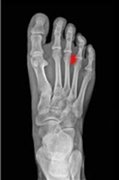
Morton’s Neuroma
A Neuroma is an abnormal growth of nerve tissue which causes pain, Morton’s neuroma is felt on the underside of the toes, the third and fourth commonly (see picture). It can feel like a small electric shock or a tingling pain - this is caused by the friction of the toes rubbing or banging together
Running Tips HQ: If you suffer from Morton’s Neuroma (or simply want to prevent it), try wide fit running shoes (New Balance specialise in wide fit running shoes)– this will prevent your toes from being bunched too close together – also consider a minimalist running shoe - these also cater for the wider foot
Black Toenail
This is caused by pressure from running shoes on the toenail (toe banging the end of the shoe) - it happens a lot with downhill running. Bleeding under the nail causes it to look black, it is painful and doesn’t look good in sandals!
General Running Injuries
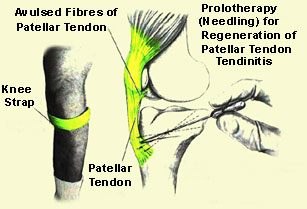
Tendonitis
Tendons are tissues which attach muscle to bones, when inflamed through injury or repetitive stress this is known as tendonitis. Key areas for a runner are knees and feet, one of the most painful being Achilles tendonitis
Patellar tendinitis of the knee can be treated moderately with the RICE method and in serious cases needle therapy to regenerate the tendon (ouch)
Shin Splints
This is a general term used for pain in the front of the lower legs, it can be a number of conditions including stress fractures, tendonitis, or compartment syndrome. Beginners can often experience this when running too far, too soon or too fast. Also hill runners put more strain on their shins
Running Cramps
A painful prolonged contraction of the muscles which can literally bring you to your knees. The muscle can feel rock hard and tight – marathon runners are often affected when the muscles are extremely tired. More on running cramps here
Stress Fractures
This is a tiny crack in the bone and are not always picked up on x-rays. Pain is the main symptom when the affected bone is bearing weight, especially at the start and end of a run, with an ease in the middle. Be mindful here, stress fractures are often self-diagnosed incorrectly and something else could be causing the pain – as always if in doubt, go and see the Doctor who will arrange for an MRI scan to confirm
wow...
All These Running Injuries – Should I Be Doing This To My Body?
As a beginner runner you might be sat there wondering if running is worth the risk of getting injured – relax…
Take measures to avoid injury (first priority)
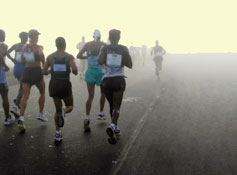
- And if you do get injured stay positive and return stronger (learn from your mistakes)
I was off the road for 6 months with Achilles tendinopathy in 2009, but as I returned to running I started strengthening the Achilles area as part of my training, avoiding the problem ever since, touch wood (more about strength training for runners here >>>)
Running, after all, is a journey – if you can avoid running injuries or be able to deal with them and treat them if they happen, your journey will be a long one ;-)
